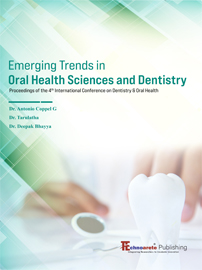


Dept of Endodontics and Conservative Dentistry, Chettinad dental college and research institute, Kanchipuram, India;
Corresponding Author:deepulakshman281998@gmail.com
Dept of Endodontics and Conservative Dentistry, Chettinad dental college and research institute, Kanchipuram, India;
Corresponding Author:nikeshraji265@gmail.com
Dept of Endodontics and Conservative Dentistry, Chettinad dental college and research institute, Kanchipuram, India;
Corresponding Author:drsadasiva@yahoo.co.in
Dept of Endodontics and Conservative Dentistry, Chettinad dental college and research institute, Kanchipuram, India;
Corresponding Author:dr.anupama@gmail.com
LASER is an acronym for 'Light Amplification by Stimulated Emission of Radiation.' 'Zur Quantum Theorie Der Stralung' (Notion of Wavelength) a work by Albert Einstein's, published in 1916, is widely credited with the invention of the concept of spontaneous emission of radiation. Testing with microwaves, Charles Townes created a system in 1953 that allowed this radiation to be amplified when passed through ammonia gas. In 1960, Miaman was the first to introduce laser dentistry and its hard and soft tissue applications. A collimated and coherent beam of light is emitted by lasers.1 Laser is a photon of a single wavelength. Laser emits light by optical magnification. Light is a form of energy produced by electromagnetic radiation which moves at a constant speed by wave motion. The photon or light particle is the fundamental unit of radiant energy. Soft tissue applications include healing of wounds, excision of hyperplastic tissue of impacted teeth, photodynamic therapies for tumors and removing restoration, prevention of caries, bleaching, curing, dentinal hypersensitivity, preparation of cavity, growth modulation, and diagnostic needs are among the hard tissue applications Diode Laser, , Neodymium:YAG, Erbium Chromium:YSGG ,He:Ne and Erbium:YAG (Er:YAG) Laser are the most often used lasers in endodontics. Despite the fact that lasers are somewhat more expensive than traditional therapy, they are an useful tool for increasing the efficiency, specificity, convenience, and comfort of dental treatment
[1] Hagen, R. Globalisation, university transformation and eco nomic regeneration: A UK case study of public/private sector partnership. International Journal of Public Sector Management, 15, 204—218. 2002
[2] . Sumita Giri Nishad1 , Muhammad Nishad Thyath2 , Meha Sharma2 , Iram Zaidi2 LASER IN ENDODONTICS Journal of Advanced Medical and Dental Sciences Research |Vol. 3|Issue 2| April - June 2015
[3] Dr.K.Amudhalakshmi1 , Dr. A. Nandhini2 , Dr.M.S.Sharmila3 , Dr. S.Venkatesh Lasers in Conservative Dentistry And Endodontics- A Review
[4] . Ramu Shobhana Applications of laser in the field of Endodontics : an update European Journal of Molecular & Clinical Medicine ISSN 2515-8260 Volume 07, Issue 10, 2020
[5] Carmen d. M. Todea; Laser applications in conservative dentistry; TMJ 2004; 54(4): 392-405.
[6] Krause F, Jepsen S, Braun A. Comparison of two laser fluorescence devices for the detection of occlusal caries in vivo. Eur J Oral Sci 2007; 115: 252–56.
[7] Tobin M. Oral cancer in a blue spotlight as more dentists buy screening devices. The Canadian Press 2007;22: 134-37.
[8] Burkes EJ, Hoke J, Gomes E, Wolbarsht M. Wet versus dry enamel ablation by the Er: YAG laser. J Prosthet Dent 1992; 67: 847-51
[9] .Dostalova T, Jelinkova H, Kucerova H, Krejsa O, Hamal K, Kubelka J, et al. Er: YAG laser ablation: Clinical evaluation. J Clin Laser Med Surg 1998; 16(5): 273- 82.
[10] Martinez-Insua A, Dominguez LS, Rivera FG, Santana-Penin UA. Differences in bonding to acid-etched or Er: YAG – laser – treated enamel and dentine surfaces. J Prosthet Dent, 2000; 84: 280-88.
[11] María Peñarrocha-DiagoApel C, Meister J, Gotz H, Duschner H, Gutknecht N. Structural changes in the human dental enamel after subablative erbium laser irradiation and its potential use for caries prevention. Caries Res 2005; 39:65-70.
[12] Staninec M, Xie J, Le CQ, Fried D. Influence of an optically thick water layer on the bond-strength of composite resin to dental enamel after IR laser ablation. Lasers Surg Med 2003; 33:264-69
[13]Schwarz F, Arweiler N, Georg T, Reich E . Desensitising effects of an Er: YAG laser on hypersensitive dentine; a controlled, prospective clinical study. J Clin Periodontol 2002; 29: 211-15.
[14] Berutti E, Marini R, Angerreti A. Penetration ability of different irrigants into dentinal tubules. J Endod 1997; 23:725-727
[15]Robert Pong-Yin Ng: Sterilization in root canal treatment: current advances. Hong kong dental journal.2004; 1:52-57
[16] L.Bergmans et al: Effect of photo activated disinfection on endodontic pathogens ex vivo. EJ. 2007; Vol 41(3): 227-239
[17] Daniel Humberto Pozzo et al: CO , Er: YAG andNd:YAG 2 lasers in endodontic surgery. J appl Oral Sci.2009; 17(6):596-599
[18] Verma SK, Maheshwari S, Singh RK, Chaudhari PK. Laser in dentistry: An innovative tool in modern dental practice. Natl J Maxillofac Surg. 2012 Jul;3(2):124-32
[19] Koçak S, Çiçek E, Sağlam BC, Koçak MM, Türker SA. Influence of diode laser application on the efficiency of QMiX and EDTA solutions in removing smear layer. Photomed Laser Surg. 2015 Nov;33(11):564-7.
[20] Xhevdet A, Stubljar D, Kriznar I, Jukic T, Skvarc M, Veranic P, Ihan A. The disinfecting efficacy of root canals with laser photodynamic therapy. J Lasers Med Sci. 2014;5(1):19-26. 24
[21] Ahmed HM, Abbott PV. Discolouration potential of endodontic procedures and materials: a review. Int Endod J. 2012 Oct;45(10):883-97
[22] Nisha Garg and Amit Garg-Textbook of endodontics